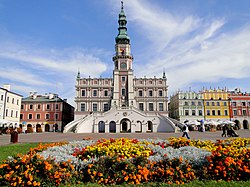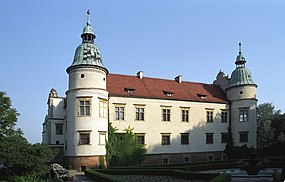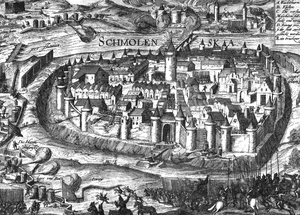History of the Polish–Lithuanian Commonwealth (1569–1648)
The formal rule of the nobility, which was a much greater proportion of the population than in other European countries, constituted a sophisticated early democratic system,[2] in contrast to the absolute monarchies prevalent at that time in the rest of Europe.Following the Reformation gains (the Warsaw Confederation of 1573 was the culmination of the unique in Europe religious toleration processes), the Catholic Church embarked on an ideological counter-offensive and Counter-Reformation claimed many converts from Protestant circles.For those reasons, the way in which the Polish–Lithuanian Commonwealth expansion took place and developed had caused an aggravation of both the social and national tensions, introduced a fundamental instability into the system, and ultimately resulted in the future crises of the "Republic of Nobles".[23] Michał Sędziwój (Sendivogius Polonus) was a famous in Europe alchemist, who wrote a number of treatises in several languages, beginning with Novum Lumen Chymicum (1604, with over fifty editions and translations in the 17th and 18th centuries).During the second half of the 17th century, for a variety of reasons, including abuse of the unanimity rule (liberum veto), sejm's effectiveness had declined, and the void was being increasingly filled by sejmiks, where in practice the bulk of government's work was getting done.[35] During the interregnum the szlachta prepared a set of rules and limitations for the future monarch to obey as a safeguard to ensure that the new king, who was going to be a foreigner, complied with the peculiarities of the Commonwealth's political system and respected the privileges of the nobility.The Henrician Articles summarized the accumulated rights of Polish nobility, including religious freedom guarantees, and introduced further restrictions on the elective king; as if that were not enough, Henry also signed the so-called pacta conventa, through which he accepted additional specific obligations.Of Batory's confrontations with members of the nobility, the famous case involved the Zborowski brothers: Samuel was executed on Zamoyski's orders, Krzysztof was sentenced to banishment and property confiscation by the sejm court.The prospect of a personal union with Sweden raised for the Polish and Lithuanian ruling circles political and economic hopes, including favorable Baltic trade conditions and a common front against Russia's expansion.The resulting void was being filled during the late 16th and 17th centuries by the increasingly active and assertive territorial sejmiks, which provided a more accessible and direct forum for szlachta activists to promote their narrowly conceived local interests.[47] Cossacks were first semi-nomadic, then also settled East Slavic people of the Dnieper River area, who practiced brigandage and plunder, and, renowned for their fighting prowess, early in their history assumed a military organization.[48] Such excursions, executed by formal subjects of the Polish king, were intolerable from the point of view of foreign relations of the Commonwealth, because they violated peace or interfered with the state's current policy toward the Ottoman Empire.[51] During that time the private dukedoms of Ukrainian potentates, such as the families of Kalinowski, Daniłowicz and Wiśniowiecki, rapidly expanded and the folwark–serfdom economy, only then (much later than in other parts of the Polish Crown) being introduced in Ukraine, caused still unprecedented levels of exploitation.The resulting opportunity for the Polish–Lithuanian state to improve its position depended on its ability to overcome internal distractions, such as the isolationist and pacifist tendencies that prevailed among the szlachta ruling class, or the rivalry between nobility leaders and elected kings, often intent on circumventing restrictions on their authority, such as the Henrician Articles.Zamoyski's politics and actions, which constituted the earlier stage of the Moldavian magnate wars, only prolonged Poland's influence in Moldavia and interfered effectively with the simultaneous Habsburg plans and ambitions in this part of Europe.[56] Jürgen von Farensbach, given the command of the Commonwealth forces, was overpowered by the much larger army brought to the area by Charles, whose quick offensive resulted in the 1600 take-over of most of Livonia up to the Daugava River, except for Riga.In the armistice of 1611 the Commonwealth was able to keep the majority of the contested areas, as a variety of internal and foreign difficulties, including the inability to pay the mercenary soldiers and the Union's new involvement in Russia, precluded a comprehensive victory.As Boris Godunov encountered resistance from both the peasant masses and the boyar opposition, in the Commonwealth the ideas of turning Russia into a subordinated ally, either through a union, or an imposition of a ruler dependent on the Polish–Lithuanian establishment, were rapidly coming into play.Under arrangements negotiated by Żółkiewski, the boyars deposed Tsar Vasili and accepted Władysław in return for peace, no annexation of Russia into the Commonwealth, the Prince's conversion to the Orthodox religion, and privileges, including exclusive rights to high offices in the Tsardom granted to the Russian nobility.Prince Dmitry Pozharsky and Kuzma Minin effectively led the Russians, a new rescue operation attempted by Hetman Chodkiewicz had failed and a capitulation of the Polish and Lithuanian forces at the Kremlin terminated in 1612 their involvement there.The threat posed by a potentially resurgent Habsburg monarchy to the situation of Polish Silesians was keenly felt, and there were voices within King Sigismund's circle, including Stanisław Łubieński and Jerzy Zbaraski, who brought to his attention Poland's historic rights and options in the area.[60] The ten thousand men strong Lisowczycy mercenary division, a highly effective military force, had just returned from the Moscow campaign, and having become a major nuisance for the szlachta, was available for another assignment abroad; Sigismund sent them south to assist Emperor Ferdinand II.Later during the war years the province was repeatedly ravaged in the course of military campaigns crossing its territory, and at one point a Protestant leader, Piast Duke John Christian of Brieg, appealed to Władysław IV Vasa for assuming supremacy over Silesia.Ottoman chief Iskender Pasha destroyed the magnate forces in Moldavia and compelled Stanisław Żółkiewski in 1617 to consent to the Treaty of Busza at Poland's border, in which the Commonwealth obliged not to get involved in matters concerning Wallachia and Transylvania.[62] Turkish unease about Poland's influence in Russia, the consequences of the Lisowczycy expedition against Transylvania, an Ottoman fief in 1619 and the burning of Varna by the Cossacks in 1620 caused the Empire under the young Sultan Osman II to declare a war against the Commonwealth, with the aim of breaking and conquering the Polish–Lithuanian state.In the aftermath of the failed Battle of Ţuţora (1620) Żółkiewski was killed, Koniecpolski captured, and the Commonwealth left opened defenseless, but disagreements between the Turkish and Tatar commanders prevented the Ottoman army from immediately waging an effective follow-up.The balance of power in the north had shifted in Sweden's favor, as the Baltic neighbor was led by King Gustavus Adolphus, a highly able and aggressive military leader, who greatly improved the effectiveness of the Swedish armed forces, while also taking advantage of Protestant zealotry.The Crown lands were to be also affected, as in July 1626 the Swedes took Pillau and forced Duke George William, Elector of Brandenburg and vassal of the Commonwealth in the attacked Ducal Prussia, to assume a neutrality stance.[64] Koniecpolski led a spring 1627 military campaign, trying to keep the Swedish army in the Duchy of Prussia from moving toward Gdańsk (Danzig), while also intending to block their reinforcements arriving from the Holy Roman Empire.Hetman Stanisław Żółkiewski wrote of a great slaughter in Moscow, "as on the Day of Judgement", clearly sympathizing with the untold loss and the plight of the extensive, prosperous and affluent Russian capital, burning and wasting in an enormous bloodshed.







































History of PolandPolonophilePolonizationCoat of armsMonarchsMilitary historyTerritorial evolutionJewish historyPrehistory and protohistoryStone AgeBronze and Iron AgeAntiquityPolish tribesMiddle AgesEarly Middle AgesChristianizationPiast periodJagiellonian periodEarly modernDeluge and declineThree partitionsPartitioned PolandWorld War ISecond RepublicWorld War IICommunist PolandThird RepublicTimeline of Polish historyHistory of LithuaniaKunda cultureNarva cultureNeman cultureCorded Ware cultureBaltic tribesYotvingiaAmber RoadLithuania properDuchy of LithuaniaGrand Duchy of LithuaniaKingdom of LithuaniaEarly Modern eraPolish–Lithuanian CommonwealthPartitions of the Polish–Lithuanian CommonwealthSwedish LithuaniaRussian ruleWars of IndependenceLithuanian–Soviet WarIndependence declared1940 Soviet occupationNazi occupation1944 Soviet re-occupationLithuanian Soviet Socialist RepublicIndependence restoredRepublic of LithuaniaName of LithuaniaCoat of arms of LithuaniaList of early Lithuanian dukesList of rulers of LithuaniaList of Lithuanian monarchsChronologyPolandLithuaniaUnion of Lublinmore closely unifiedpersonal unionPolonizedLithuanianRutheniannobilitycentral parliamentlocal assemblieselected kingsabsolute monarchiesReformationWarsaw Confederationreligious tolerationCatholic ChurchCounter-ReformationProtestantUnion of BrestEastern ChristiansCossackuprisingsStephen BáthorySigismund IIIWładysław IVmagnatsRussiaOttoman EmpireEastern EuropeHabsburg monarchyThirty Years' WarIvan IVLivonianLivonian WarJan Zamoyskipeace of 1582Estoniawar with Swedenperiod of instabilitymilitary invasionsTruce of DeulinoSultanOsman IIwar against the CommonwealthBattle of ŢuţoraStanisław ŻółkiewskiJan Karol ChodkiewiczBattle of Khotyn (1621)warfare with the OttomansGustavus AdolphusBaltic SeaGdańskmustered a responseStanisław KoniecpolskiAustriaTruce of Altmarkwar with Russiastatus quoconclusion of the hostilitiesRoyal PrussiaCourlandFrederick WilliamPrussianhomagePolish king













